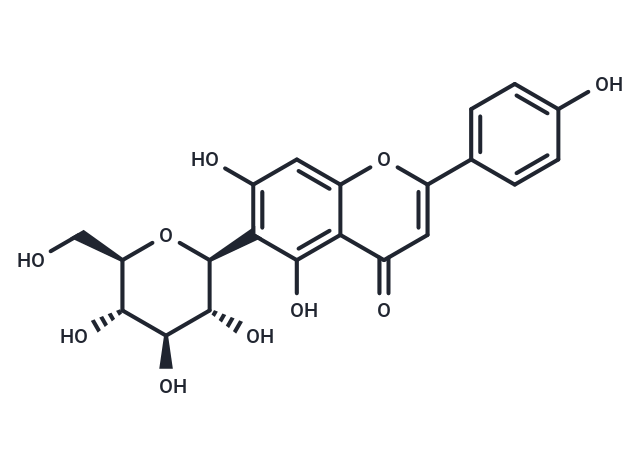Shopping Cart
- Remove All
 Your shopping cart is currently empty
Your shopping cart is currently empty

1. Isovitexin (Apigenin-6-C-Glucoside) exhibits a potential antioxidant activity. 2. Isovitexin shows a strong antihyperglycemic action, inhibits α-glucosidase in vivo.

| Pack Size | Price | Availability | Quantity |
|---|---|---|---|
| 1 mg | $44 | In Stock | |
| 5 mg | $98 | In Stock | |
| 10 mg | $143 | In Stock | |
| 25 mg | $288 | In Stock | |
| 50 mg | $433 | In Stock | |
| 100 mg | $628 | In Stock | |
| 500 mg | $1,290 | In Stock | |
| 1 mL x 10 mM (in DMSO) | $107 | In Stock |
| Description | 1. Isovitexin (Apigenin-6-C-Glucoside) exhibits a potential antioxidant activity. 2. Isovitexin shows a strong antihyperglycemic action, inhibits α-glucosidase in vivo. |
| Alias | Saponaretin, Homovitexin, Apigenin-6-C-Glucoside |
| Molecular Weight | 432.38 |
| Formula | C21H20O10 |
| Cas No. | 38953-85-4 |
| Smiles | OC[C@H]1O[C@H]([C@H](O)[C@@H](O)[C@@H]1O)c1c(O)cc2oc(cc(=O)c2c1O)-c1ccc(O)cc1 |
| Relative Density. | 1.686 g/cm3 (Predicted) |
| Storage | store at low temperature,keep away from direct sunlight | Powder: -20°C for 3 years | In solvent: -80°C for 1 year | Shipping with blue ice. |
| Solubility Information | DMSO: 86.6 mg/mL |

Copyright © 2015-2024 TargetMol Chemicals Inc. All Rights Reserved.